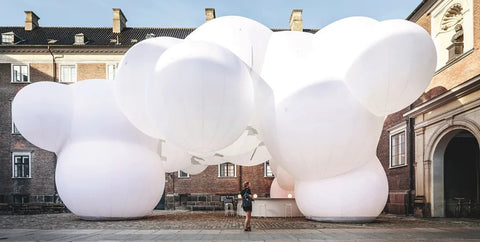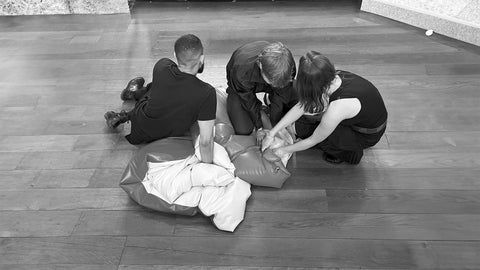
Challenging the common perception of the human form is HARRI’s raison d’être. An inspiration built upon his former bodybuilding past, HARRI is driven to incorporate unforeseen scales of proportion into contemporary fashion, drawing inspiration from Neolithic origins and art gods such as Jean-Paul Goude, Bill Brandt and Michelangelo. Commencing with his lauded Striped Swirl Inflatable Trousers in 2020, his subsequent collections have all centred on exaggerating the human physique through inflation, including his acclaimed fourth instalment at the most recent London Fashion Week.
Naturally, with all great ideas comes the challenge of execution. HARRI knew he was inspired to exaggerate structure, but found difficulty in deciding the best practice. The obvious solution was to use padding to build shape, but the designs were clumsy and wasted too much material. Primarily an artist, HARRI takes great inspiration from the natural world and places great importance on sustainable and environmentally-friendly work practices. Further solutions, such as polymaterials, were also wasteful and failed to provide the desired creative scope.
HARRI carefully considered what practices could push the boundaries of creative freedom. As a highly curious and pensive individual, HARRI was adamant about avoiding the traditional routes of garment making. The artists who have inspired HARRI’s work were disruptors and pioneers who forged their own paths, rebellious to the conventional ways of the masses. Therefore, when reading Bubbletecture by Sharon Francis, HARRI learned of the great artistic achievements made using inflatable technology and realised he had discovered his perfect tool.

Pneumatic Structure: Membrane structure that is stabilised by the pressure of compressed air. (Britannica, 2016)
Inflatable architecture and Pneumatic structures can be traced back to the 1960s, an era recognised for the international “space race” and scientific innovation. Whilst inflatable technology was used to deploy radio antennae and provide weightlessness to aeronautical ships, the Viennese powerhouse Haus-Rucker & Co explored how inflatable technology can be adapted into modern art forms to serve as a critique of bourgeois society.
Their exploration of Pneumatic Architecture criticised permanent and confined spaces. Their work encompassed a series of inflatable helmets, including the “Fly Head,’ designed to create an entirely new apprehension of reality by distorting sight and sound. Other installations introduced temporality and the concept that environments can exist one day and disappear the next, challenging the notion that architecture must be durable and permanent.

Laurids, Zamp and Pinter with 'Environment Transformen' (Flyhead, Viewatomizer, Drizzler), 1968
Social criticism and temporality are prevalent ideas among other pioneers of Pneumatic art. Jeff Koons, famous for his “Balloon Dog” series, channels playful innocence and childhood nostalgia, creating a balloon dog to remind us of play-parties and the funfairs we attended as children. His work staunchly criticises consumerism, urging us to reconsider what is truly valuable and instead, remember the innocent, happy nature associated with childhood.
In comparison, Christo and Jeanne-Claude created large-scale environmental installations to celebrate the beauty of nature, including their most notable piece ‘The London Mastaba’. Their work encourages their viewers to re-engage with their surroundings and, like HARRI, offers new perceptions of the world around them. Their pieces centred around impermanence and temporality aim to foster a spiritual connection between art and our natural environment.
For HARRI, inflatable architecture is less of a social criticism but a playful entryway into the ridiculous and undiscovered. When designing his creations, he often reflects on the impossible and the contemporary but also considers the simple question of how the world would look from his beloved pet’s point of view. His design process can be both profound and a playful reminder not to take life so seriously. For this inflation is the perfect instrument. It is an unusual medium essential to HARRI and our unique brand - we would not be where we are without it.
Discover the latest insights, trends, and behind-the-scenes stories, including our upcoming London Fashion Week showcase by subscribing to our blog and following us on Facebook, Instagram, TikTok, Pinterest, and YouTube.
Be the first to know about new collections, exclusive offers, and exciting updates by signing up for our mailing list.
Be daring. Be playful. Be bold.
Cover Picture Credits: Designed by Danish architects BIG, Skum is named for the Danish word for 'foam' Rasmus Hjortshoj





